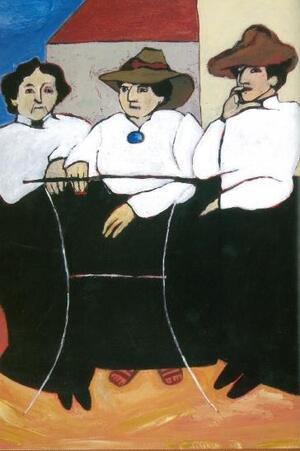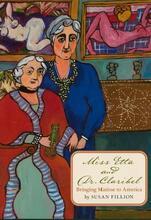Etta Cone
Claribel Cone, Gertrude Stein, Etta Cone in Italy, 1903.
Illustration by Susan Fillion.
Used by permission of David Godine, Publisher.
When Etta Cone’s father, a successful textile merchant, died in 1897, he left her and her sister Claribel with a substantial yearly income, which they used to travel regularly to Europe. There they bought paintings by Corot, Manet, Gauguin, Cezanne, Picasso, and Matisse, who became a close friend of Etta’s. The Cone sisters’ long friendship with Gertrude Stein, whom they came to know as young people in Baltimore, was crucial to their collecting. Etta spent significant time in Stein’s inner circle in Paris, but the two later had a falling out. Etta continued collecting art after her sister’s death in 1929, and their collection of primarily modern art as well as textiles and period furniture, eventually containing over two hundred pieces, was willed to the Baltimore Museum of Art.
Overview and Early Life
Though her formal education ended when she graduated from Baltimore’s Western Female High School in 1887, Etta Cone, often overshadowed by her more flamboyant sister Claribel Cone, assembled with Claribel one of the major private art collections of the century. For years, the sisters squeezed Matisses, Picassos, glorious textiles, and period furniture into the apartments they maintained and graciously displayed on Eutaw Place in Baltimore. Outliving Claribel by twenty years, Etta bequeathed their joint collections to the Baltimore Museum of Art.
Etta Cone was born on November 30, 1870, in Jonesboro, Tennessee, the ninth of thirteen children of Herman and Helen (Guggenheimer) Cone (formerly Kahn) and their third daughter. Both sides of the family were German Jews without much attachment to religious practice, though the elder Cones were synagogue members. Her family was well-to-do as the result of the business successes of her merchant father and later of her brothers Moses and Ceasar. Herman Cone’s death in 1897 left her and Claribel with comfortable incomes, and after World War I they were wealthy.
Art Collection
Etta Cone’s collecting began modestly but auspiciously in 1898 when she purchased five paintings by American impressionist Theodore Robinson for the family parlor. The Cone sisters’ long friendship with Leo and Gertrude Stein, whom they came to know as young people in Baltimore, was crucial to their collecting. Etta’s taste in art was nurtured and excited by an intense month in the summer of 1901 that she and several friends spent in Italy with Leo Stein. From 1903 to 1906, both sisters spent considerable time in Paris with Gertrude and Leo and with their relatives Michael and Sally Stein. Diaries and letters document high spirits and shopping sprees. The fall and winter of 1905–1906 were key for the inception of the Cones’ collection; Etta bought her first Matisse and her first Picasso from the artists and ventured further into textiles, jewelry, laces, and Japanese prints.
Moses Cone died in 1908. Etta, who adored her brother, went through a long period of grief. In 1912, she resumed her summer trips to Europe, which featured ebullient Stein-Cone reunions. Yet only after World War I did the sisters start consciously building their collection, their summer buying alternating with winters in Baltimore. Their tastes were complementary, Claribel’s often bolder.
Etta Cone’s complicated relationship with Gertrude Stein included years of strong attachment, then feelings of hurt, then ambivalence. She typed the manuscript of Three Lives from Stein’s handwriting in the winter of 1905–1906, while they were still close. But starting in 1907, as Alice B. Toklas became Stein’s life partner, the relationship became cooler.
Neither as a young woman nor later did Etta Cone participate actively in the diverse and lively Jewish organizational life of Baltimore; her meticulous record books, however, do show contributions to several Jewish charities. The opening of a letter to Gertrude Stein dated September 9, 1907, “Happy New Year to you, you heathen,” combines Jewish identification with humorous distancing.
Claribel died in 1929. Etta gradually overcame grief and resumed her yearly buying trips, always accompanied by a young woman companion. She strengthened the collection with significant works of Corot, Manet, and Gauguin and developed an increasingly close friendship with Henri Matisse, who often set aside a few paintings he thought she would like in anticipation of her yearly visits. After 1938, she no longer traveled to Europe but still purchased art and gloried in showing visitors the collection. She died on August 31, 1949.
Burke, Carolyn. “Gertrude Stein, the Cone Sisters, and the Puzzle of Female
Friendship.” Critical Inquiry 8, no. 3 (Spring 1982): 543–564.
Cone, Etta. Archives and personal library. Baltimore Museum of
Art; DAB 4; EJ, s.v. “Cone”.
Fein, Isaac M. The Making of an American Jewish Community: The History of
Baltimore Jewry from 1773 to 1920 (1971).
Hirschland, Ellen B. “The Cone Sisters and the Stein Family.” In Four Americans
in Paris: The Collections of Gertrude Stein and Her Family, edited by Margaret Potter (1970); NAW.
Hirschland, Ellen B., and Nancy H. Ramage. The Cone Sisters of Baltimore: Collecting at Full Tilt. Evanston, IL: Northwestern University Press, 2008.
Pollack, Barbara. The Collectors: Dr. Claribel and Miss Etta Cone (1962).
Richardson, Brenda. Dr. Claribel and Miss Etta (1985); UJE, s.v. “Cone”.
Wineapple, Brenda. Sister Brother: Gertrude and Leo Stein (1996); WWIAJ (1926,
1928).




